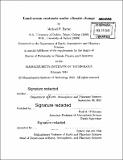| dc.contributor.advisor | Paul A. O'Gorman. | en_US |
| dc.contributor.author | Byrne, Michael P | en_US |
| dc.contributor.other | Massachusetts Institute of Technology. Department of Earth, Atmospheric, and Planetary Sciences. | en_US |
| dc.date.accessioned | 2015-06-10T19:10:34Z | |
| dc.date.available | 2015-06-10T19:10:34Z | |
| dc.date.copyright | 2015 | en_US |
| dc.date.issued | 2015 | en_US |
| dc.identifier.uri | http://hdl.handle.net/1721.1/97332 | |
| dc.description | Thesis: Ph. D. in Climate Physics and Chemistry, Massachusetts Institute of Technology, Department of Earth, Atmospheric, and Planetary Sciences, 2015. | en_US |
| dc.description | Cataloged from PDF version of thesis. | en_US |
| dc.description | Includes bibliographical references (pages 155-163). | en_US |
| dc.description.abstract | Observations and climate models show a pronounced land-ocean contrast in the responses of surface temperature and the hydrological cycle to global warming: Land temperatures increase more than ocean temperatures, low-level relative humidity increases over ocean but decreases over land, and the water cycle has a muted response over land in comparison to ocean regions at similar latitudes. A comprehensive physical understanding of these land-ocean contrasts has not been established, despite the robustness of the features and their importance for the regional and societal impacts of climate change. Here we investigate land-ocean contrasts in temperature, relative humidity, and precipitation minus evaporation (P - E) under climate change using both idealized and full-complexity models. As in previous studies, we find enhanced surface warming over land relative to the ocean at almost all latitudes. In the tropics and subtropics, the warming contrast is explained using a convective quasi-equilibrium (CQE) theory which assumes equal changes in equivalent potential temperature over land and ocean. As the CQE theory highlights, the warming contrast depends strongly on changes in relative humidity, particularly over land. The decreases in land relative humidity under warming can be understood using a conceptual model of moisture transport between the land and ocean boundary layers and the free troposphere. Changes in P - E over ocean are closely tied to the local surface-air temperature changes via a simple thermodynamic scaling; the so-called "rich-get-richer" mechanism. Over land, however, we show that the response has a smaller magnitude and deviates substantially from the thermodynamic scaling. We examine the reasons for this land-ocean contrast in the response of P - E by analyzing the atmospheric moisture budget. Horizontal gradients of surface temperature and relative humidity changes are found to be important over land, with changes in atmospheric circulation playing a secondary role outside the tropics. An extended thermodynamic scaling is introduced and is shown to capture the multimodel-mean response of P - E over land, and the physical mechanisms behind the extended scaling are discussed. | en_US |
| dc.description.statementofresponsibility | by Michael P. Byrne. | en_US |
| dc.format.extent | 163 pages | en_US |
| dc.language.iso | eng | en_US |
| dc.publisher | Massachusetts Institute of Technology | en_US |
| dc.rights | M.I.T. theses are protected by copyright. They may be viewed from this source for any purpose, but reproduction or distribution in any format is prohibited without written permission. See provided URL for inquiries about permission. | en_US |
| dc.rights.uri | http://dspace.mit.edu/handle/1721.1/7582 | en_US |
| dc.subject | Earth, Atmospheric, and Planetary Sciences. | en_US |
| dc.title | Land-ocean contrasts under climate change | en_US |
| dc.type | Thesis | en_US |
| dc.description.degree | Ph. D. in Climate Physics and Chemistry | en_US |
| dc.contributor.department | Massachusetts Institute of Technology. Department of Earth, Atmospheric, and Planetary Sciences | |
| dc.identifier.oclc | 910512977 | en_US |
